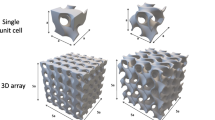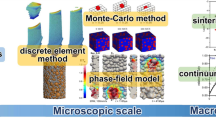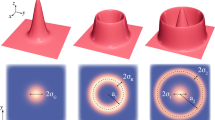Abstract
Serious spatter defects occur with the intensive interaction between a high-power density laser beam (> 107 W/cm2) and the material used in high-power (HP) laser welding. In this study, we developed a three-dimensional comprehensive model to physically simulate the keyhole and weld pool dynamics in HP laser welding. Our recent proposed adaptive mesh-refinement method was adopted to solve the model. An interesting phenomenon was directly observed: the intense localized boiling on the mesoscale keyhole wall induced many small spatters (LBiS), sized hundreds of microns, during 10 kW HP laser welding of 304 stainless steel. Experimental studies of parameters were also conducted to validate the model and characterize the spatter behaviors outside the keyhole wall during welding. The theoretical predictions of LBiS behaviors agreed well with the experimental observations. Moreover, the flying directions of LBiS generally approached vertical and were relatively insensitive to welding speed, even when the speed was increased to a very high value of 15 m/min. This finding shows that LBiS are very different from the commonly observed spatter defects produced by the intense friction effect of a vapor plume toward the keyhole, and this finding demonstrates the variety of the spatters. Furthermore, an energy conservation theory was proposed to characterize LBiS, and a novel dimensionless spatter number was formulated to calculate their formation threshold. The spatter number relates to the Reynold and Weber numbers of the molten flow of the weld pool and shows the relative importance of an inertia flow driven by the recoil pressure and the resistance from viscous dissipation, surface tension and gravity. The spatter number was less than 1 when LBiS was formed. The proposed theory was validated against the numerical predictions, and good agreements were obtained.










Similar content being viewed by others
References
M. Mizutani, S. Katayama, Y. Kawahito, Elucidation of high-power fibre laser welding phenomena of stainless steel and effect of factors on weld geometry. J. Phys. D Appl. Phys. 40(19), 5854 (2007)
Y. Kawahito, M. Mizutani, S. Katayama, High quality welding of stainless steel with 10 kw high power fibre laser. Sci. Technol. Weld. Join. 14(4), 288–294 (2009)
H. Park, S. Rhee, Analysis of mechanism of plasma and spatter in CO2 laser welding of galvanized steel. Opt. Laser Technol. 31(31), 119–126 (1999)
J. Volpp, Formation mechanisms of pores and spatters during laser deep penetration welding. J. Laser Appl. 30(1), 012002 (2018)
J. Weberpals, F. Dausinger, Fundamental understanding of spatter behavior at laser welding of steel. Proceedings of the 27th ICALEO conference, 704 (2008)
S. Katayama, Y. Kawahito, Elucidation of phenomena in high-power fiber laser welding and development of prevention procedures of welding defects. Proc. SPIE Int. Soc. Opt. Eng. 146(1), 124-126 (2009)
D. Wu, X. Hua, F. Li, L. Huang, Understanding of spatter formation in fiber laser welding of 5083 aluminum alloy. Int. J. Heat Mass Transfer 113, 730–740 (2017)
A.F.H. Kaplan, J. Powell, Spatter in laser welding. J. Laser Appl. 23(23), 3337–3344 (2011)
A.F.H. Kaplan, I. Eriksson, J. Powell, Measurements of fluid flow on keyhole front during laser welding. Sci. Technol. Weld. Join. 16(7), 636–641 (2011)
A. Matsunawa, V. Semak, The simulation of front keyhole wall dynamics during laser welding. J. Phys. D Appl. Phys. 30(5), 798 (1997)
A. Matsunawa, N. Seto, J.D. Kim, S. Katayama, Dynamics of keyhole and molten pool in high-power CO2 laser welding. J. Laser Appl. 10(6), 247–254 (2000)
M.J. Zhang, G.Y. Chen, Y. Zhou, S.C. Li, H. Deng, Observation of spatter formation mechanisms in high-power fiber laser welding of thick plate. Appl. Surf. Sci. 280(9), 868–875 (2013)
S. Pang, X. Chen, X. Shao, S. Gong, J. Xiao, Dynamics of vapor plume in transient keyhole during laser welding of stainless steel: local evaporation, plume swing and gas entrapment into porosity. Opt. Lasers Eng. 82, 28–40 (2016)
S. Pang, W. Chen, W. Wang, A quantitative model of keyhole instability induced porosity in laser welding of titanium alloy. Metall. Mater. Trans. A 45(6), 2808–2818 (2014)
R. Rai, T.D. Roy, Tailoring weld geometry during keyhole mode laser welding using a genetic algorithm and a heat transfer model. J. Phys. D Appl. Phys. 39(6), 1257–1266 (2006)
J. Zhou, H.L. Tsai, T.F. Lehnhoff, Investigation of transport phenomena and defect formation in pulsed laser keyhole welding of zinc-coated steels. J. Phys. D Appl. Phys. 39(24), 5338 (2006)
R. Scardovelli, S. Zaleski, Direct numerical simulation of free-surface and interfacial flow. Ann. Rev. Fluid Mech. 31(1), 567–603 (1999)
G.D. Weymouth, D.K.P. Yue, Conservative volume-of-fluid method for free-surface simulations on Cartesian-grids. J. Comput. Phys. 229(8), 2853–2865 (2010)
D.L. Youngs, Time-dependent Multi-material Flow with Large Fluid Distortion, in Numerical Methods for Fluid Dynamics, ed. by K.W. Morton, M.J. Baines (Academic, New York, 1982), p. 273
R. Hu, S. Pang, X. Chen, L. Liang, X. Shao, An octree-based adaptive mesh refinement method for three dimensional modeling of keyhole mode laser welding. Int. J. Heat Mass Transfer 115, 258–263 (2017)
D. Fuster, A. Bagué, T. Boeck, Simulation of primary atomization with an octree adaptive mesh refinement and VOF method. Int. J. Multiph. Flow 35(6), 550–565 (2009)
M.M. Francois, S.J. Cummins, E.D. Dendy, A balanced-force algorithm for continuous and sharp interfacial surface tension models within a volume tracking framework. J. Comput. Phys. 213(1), 141–173 (2006)
S. Pang, K. Hirano, R. Fabbro, T. Jiang, Explanation of penetration depth variation during laser welding under variable ambient pressure. J. Laser Appl. 27(2), 022007 (2015)
S. Pang, X. Chen, J. Zhou, X. Shao, C. Wang, 3D transient multiphase model for keyhole, vapor plume, and weld pool dynamics in laser welding including the ambient pressure effect. Opt. Lasers Eng. 74, 47–58 (2015)
S. Pang, L. Chen, J. Zhou, Y. Yin, T. Chen, A three-dimensional sharp interface model for self-consistent keyhole and weld pool dynamics in deep penetration laser welding. J. Phys. D Appl. Phys. 44(2), 025301 (2011)
G.H. Miller, P. Colella, A conservative three-dimensional Eulerian method for coupled solid–fluid shock capturing. J. Comput. Phys. 183(1), 26–82 (2002)
Z.S. Saldi, Marangoni driven free surface flows in liquid weld pools (Delft University of Technology, Delft, 2012)
H. Ki, J. Mazumder, P.S. Mohanty, Modeling of laser keyhole welding: Part I. Mathematical modeling, numerical methodology, role of recoil pressure, multiple reflections, and free surface evolution. Metall. Mater. Trans. A 33(6), 1817–1830 (2002)
W.I. Cho, S.J. Na, M.H. Cho, Numerical study of alloying element distribution in CO2 laser–GMA hybrid welding. Comput. Mater. Sci. 49(4), 792–800 (2010)
X. He, J.T. Norris, P.W. Fuerschbach, Liquid metal expulsion during laser spot welding of 304 stainless steel. J. Phys. D Appl. Phys. 39(3), 525 (2006)
M.J. Zhang, G.Y. Chen, Observation of spatter formation mechanisms in high-power fiber laser welding of thick plate. Appl. Surf. Sci. 280(9), 868–875 (2013)
D. Wu, X. Hua, L. Huang, J. Zhao, Numerical simulation of spatter formation during fiber laser welding of 5083 aluminum alloy at full penetration condition. Opt. Laser Technol. 100, 157–164 (2018)
S. Katayama, Y. Kawahito, Elucidation of phenomena in high-power fiber laser welding and development of prevention procedures of welding defects, in Fiber lasers VI: technology, systems, and applications. International Society for Optics and Photonics, vol. 7195, 71951R (2009)
F. Hugger, K. Hofmann, S. Kohl, M. Dobler, M. Schmidt, Spatter formation in laser beam welding using laser beam oscillation. Weld. World 59(2), 165–172 (2015)
S. Li, G. Chen, S. Katayama, Y. Zhang, Relationship between spatter formation and dynamic molten pool during high-power deep-penetration laser welding. Appl. Surf. Sci. 303(6), 481–488 (2014)
E.H. Amara, R. Fabbro, Modelling of gas jet effect on the melt pool movements during deep penetration laser welding. J. Phys. D Appl. Phys. 41(41), 055503 (2008)
R. Fabbro, M. Hamadou, F. Coste, Metallic vapor ejection effect on melt pool dynamics in deep penetration laser welding. J. Laser Appl. 16(1), 859–870 (2004)
Y.H. Zhang, X.J. Gu, R.W. Barber, D.R. Emerson, Capturing knudsen layer phenomena using a lattice boltzmann model. Phys. Rev. E Stat. Nonlinear Soft Matter Phys. 74(2), 046704 (2006)
E.H. Amara, R. Fabbro, F. Hamadi, Modeling of the melted bath movement induced by the vapor flow in deep penetration laser welding. J. Laser Appl. 18(1), 2–11 (2006)
V. Semak, A. Matsunawa, The role of recoil pressure in energy balance during laser materials processing. J. Phys. D Appl. Phys. 30(18), 2541 (1999)
Acknowledgements
This research was financially supported by the National Natural Science Foundation of China (NSFC) (No. 51675202) and the Key R&D Projects (National Key projects) (No. 2017YFE0100100).
Author information
Authors and Affiliations
Corresponding author
Rights and permissions
About this article
Cite this article
Liu, T., Hu, R., Chen, X. et al. Localized boiling-induced spatters in the high-power laser welding of stainless steel: three-dimensional visualization and physical understanding. Appl. Phys. A 124, 654 (2018). https://doi.org/10.1007/s00339-018-2058-7
Received:
Accepted:
Published:
DOI: https://doi.org/10.1007/s00339-018-2058-7




